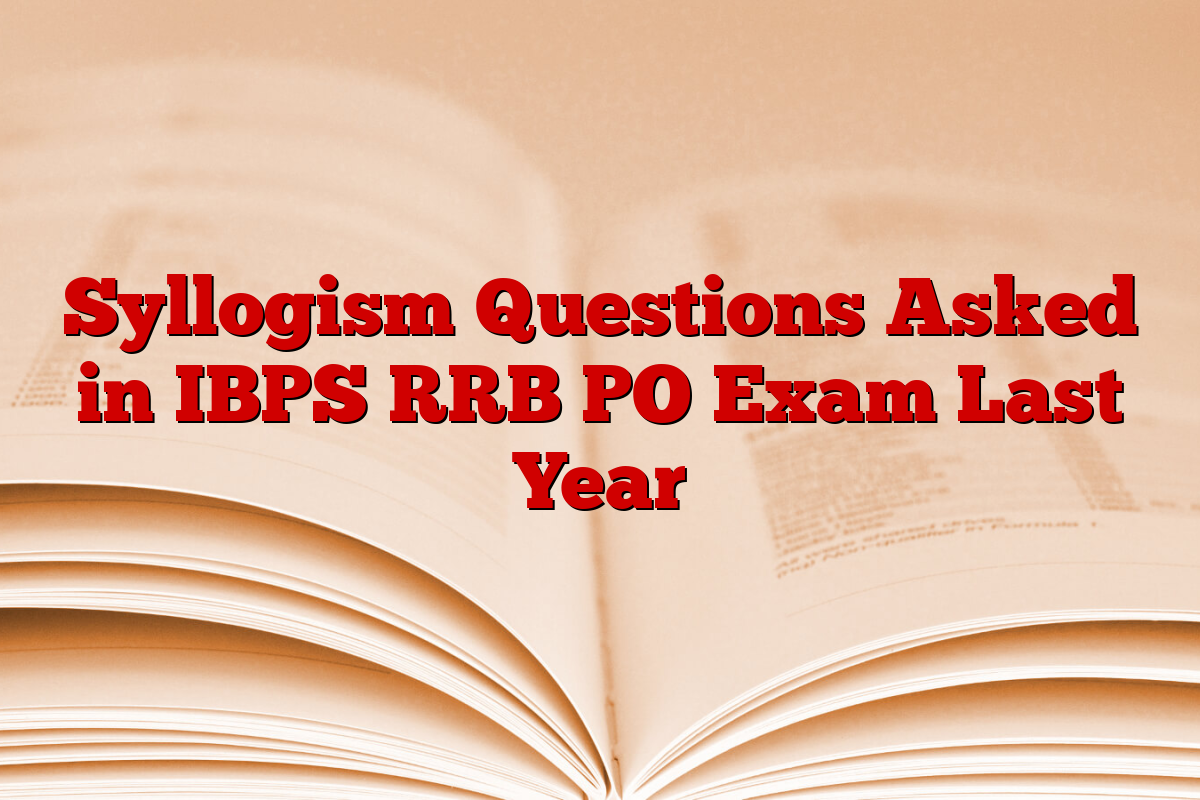Sylogism is one of the most important subjects in the logic section of IBPS RRB PO exam. Every year, questions on this subject are asked to test how a candidate can understand statements and conclude the right conclusion. These questions are based on logic and usually follow a certain pattern. They include statements and conclusions where candidates must decide whether the conclusions are logically followed by statements. To resolve them quickly and accurately, one must understand the basic rules, practice different patterns, and improve their reading and interpretation skills.
Sylogism questions asked in IBPS RRB PO exam last year
In the IBPS RRB PO Exam held last year, syllagism questions played an important role in testing the candidate’s arguments. These questions were not very long, but required proper attention and logical approach. He was asked in various forms such as two-stagnation or three-state problems with one or more conclusions. Solving such questions helps in scoring better and management time in the exam. Below we have shared the real syllabism questions asked in the previous year. IBPS RRB PO exam to help you understand the pattern and difficulty level.
Question 1:
statement:
All roses are flowers.
There are some flowering plants.
All plants are leaves.
conclusion:
I. Some leaves are flowers.
Ii. There are some rose plants.
Option:
(A) Only I only follow
(b) only follows II
(c) Either I or II is as follows
(d) Neither I nor I follow II
(e) Follow both I and II
Question 2:
statement:
There is no bird animal.
All animals are humans.
Some humans are tigers.
conclusion:
I. No bird is human.
Ii. There are some tiger animals.
Option:
(A) Only I only follow
(b) only follows II
(c) Either I or II is as follows
(d) Neither I nor I follow II
(e) Follow both I and II
Question 3:
statement:
Some books are pen.
All are pen pencils.
There is no pencil eraser.
conclusion:
I. There is no pen eraser.
Ii. Some books are not eraser.
Option:
(A) Only I only follow
(b) only follows II
(c) Either I or II is as follows
(d) Neither I nor I follow II
(e) Follow both I and II
Question 4:
statement:
All dogs are cats.
Some cats are lions.
There is no lion tiger.
conclusion:
I. Some cats are not tigers.
Ii. There is no dog tiger.
Option:
(A) Only I only follow
(b) only follows II
(c) Either I or II is as follows
(d) Neither I nor I follow II
(e) Follow both I and II
Question 5:
statement:
All are mobile laptops.
Some laptops are tablets.
All tablets are devices.
conclusion:
I. Some laptops are devices.
Ii. All are mobile devices.
Option:
(A) Only I only follow
(b) only follows II
(c) Either I or II is as follows
(d) Neither I nor I follow II
(e) Follow both I and II
Question 6.
statement:
There are some pen pencils.
Only pencils are eraser.
There is no pen marker.
conclusion:
I. There are no eraser markers.
Ii. There are some eraser markers.
Option:
(A) If I follow only conclusions.
(b) If only the conclusion follows II.
(c) If either conclusion I or II is as follows.
(d) If neither conclusion I nor II follows.
(E) If both find conclusions I and II follow.
Question 7.
statement:
Some books are not magazines.
Only some magazine are newspapers.
All newspapers are journalists.
conclusion:
I. All newspapers are magazines.
Ii. It is a possibility that all newspapers are booked.
Option:
(A) If I follow only conclusions.
(b) If only the conclusion follows II.
(c) If either conclusion I or II is as follows.
(d) If neither conclusion I nor II follows.
(E) If both find conclusions I and II follow.
Question 8. statement:
All the chairs are black.
Only a few blacks are of leather.
Only leather is brown.
conclusion:
I. Some brown chair is a possibility.
Ii. There is no black brown.
Option:
(a) If only I follow the conclusion
(b) If only the conclusion follows II
(c) If either conclusion I or II follows
(d) If neither conclusion I nor II follows
(E) If you follow both I and II
Question 9. statement:
There is no tower wave.
All the wave is green.
There are only a few green plants.
conclusion:
I. There is no wave plant.
Ii. There is no plant tower.
Option:
(a) If only I follow the conclusion
(b) If only the conclusion follows II
(c) If either conclusion I or II follows
(d) If neither conclusion I nor II follows
(E) If you follow both I and II
Question 10
All pens are blue.
Some blue are shiny.
Only shiny are expensive.
conclusion:
I. Some expensive things may be pen.
Ii. No blue thing is expensive.
(a) If only I follow the conclusion
(b) If only the conclusion follows II
(c) If either conclusion I or II follows
(d) If neither conclusion I nor II follows
(e) If both find conclusions I and II follow

